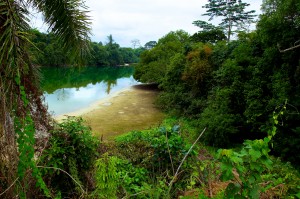Thirteen new national parks – and no way to see them?
In 2002, the west African country of Gabon made international headlines with one of the boldest moves in conservation history: then-President Omar Bongo Ondimba announced the creation of 13 national parks, comprising more than a tenth of the country’s territory.
In a recent trip to Gabon, I learned that nearly a decade later, Bongo’s bold move remains largely an unfulfilled promise. In an article and short photo essay, I chronicled the efforts of a local environmental group to bring that promise closer to reality. I came to understand why the dream of Gabon’s national park system remains an aspiration that, hopefully, might yet capture the imagination of Gabon’s current politicians – and the rest of the world.
Here’s one way to understand the scale of Omar Bongo’s vision: Gabon is about the size of Colorado, which has four national parks (Rocky Mountain, Great Sand Dunes, Mesa Verde and Black Canyon of the Gunnison) totaling about 575 square miles, or half a percent of the state’s land mass. If we expanded Colorado’s national parks by about 20 times, that would be close to what Gabon’s late president had envisioned for his country.
Instead of elk, moose, mountain lions, bear, deer and antelope that grace Colorado’s wildscapes, Gabon’s wildlife heritage includes its famous surfing hippopotamuses, herds of forest elephants, gorillas, chimpanzees, gazelle and some of the world’s largest remaining tracts of equatorial rainforest.
Gabon’s conservation efforts made international headlines in 2002, thanks largely to the efforts of Michael Fay, a Wildlife Conservation Society scientist who famously traversed much of Gabon’s tropical wildlands on foot, and whose efforts were documented several times in National Geographic and elsewhere (including surviving an elephant goring). One of Fay’s WCS colleagues, Lee White, went on to be named as current head of Gabon’s national park system.
All good so far. Stand by for the update. First, a little background on Gabon, and why I went there:
In September, I was invited to give journalism workshops in the capital city of Libreville, courtesy of the U.S. State Department and Gabon’s Conseil National de la Communication. I had been a Knight International Press Fellow for four months in Algeria in 2006, living in Algiers and working (in French) with journalists from both Francophone and Arabophone newspapers. I returned twice to conduct investigative journalism training sessions, observing the dance between a newly “democratic” regime and a newly “free” press.
In Gabon, as in Algeria, freedom of the press is still a fledgling concept; for four decades of Gabon’s post-independence history (it was a French colony until 1960, and its first president, Léon M’ba, served from 1961 until his death in 1967), it was ruled in what could kindly be called an autocratic way by the aforementioned President Omar Bongo Ondimba. Most of the media was state-run or state-controlled, and freedom of expression – if it meant expressing opposing views to the prevailing power – was met with wrathful displeasure.
In theory, some of that changed after the president’s death in 2009, and his son, Ali Bongo Ondimba, came to power in a disputed election. Nonetheless, the international community accepted the results, and le fils Bongo was soon being heralded as a reformer and a leader in the African continent’s new, post-post colonial politics. Press freedoms opened a crack, although without a tradition of a free press, some of the resulting journalism seemed to resemble the undisciplined acts of teenagers who had been given the car keys and a bottle of whiskey, without ever having a driving lesson. Hence, there was a perceived opening to invite a U.S. journalist to talk about the rights – and responsibilities – of a free press.
I learned during my brief time there that President Ali Bongo, by most accounts, has indeed streamlined the government, vowed to fight corruption, and notably articulated a vision of Gabon’s future based on three economic pillars: service Gabon, industrial Gabon, and Gabon Vert, or green Gabon. He still has many detractors and doubters, but has initiated some environmental initiatives, including a ban on the export of raw logs.
Now we’re back to the national parks.
Before going to Gabon, I tried to arrange a reporting trip at the conclusion of my teaching responsibilities, and thought it would be interesting to visit Loango National Park, often described as the “crown jewel” of Gabon’s parks and home to the legendary “surfing hippos.” What, I wondered, did Loango and other parks look like, nearly a decade after the fanfare of their creation?
Well, basically, I couldn’t get there from here. Or even from there. The major tourism companies had started to operate in the park weren’t operational. Flights that had once ferried tourists from the capital to a nearby airport had stopped flying. Although it would have been possible, given a little more time than I had, to get to Loango, the fact that it wasn’t obvious or easy made me wonder just what had been done in the years since Gabon had been embraced as the darling of international conservation.
Not much, as it turns out. For a hundred reasons, it is easier to proclaim the creation of a park system than it is to actually create one. Lack of infrastructure is high on the list, even though Gabon is one of Africa’s top ten oil producing countries and has a relatively tiny population of about 1.5 million.
One of those hundred reasons is the lack of a culture of formal, national conservation organizations – and a lack of any culture of environmental philanthropy. While in Libreville, I had heard about a small, regional environmental group called Muyissy Environnment, operating near three proposed national parks about 300 miles from Libreville in the south of the country. Please click on the link above to read about their efforts.

